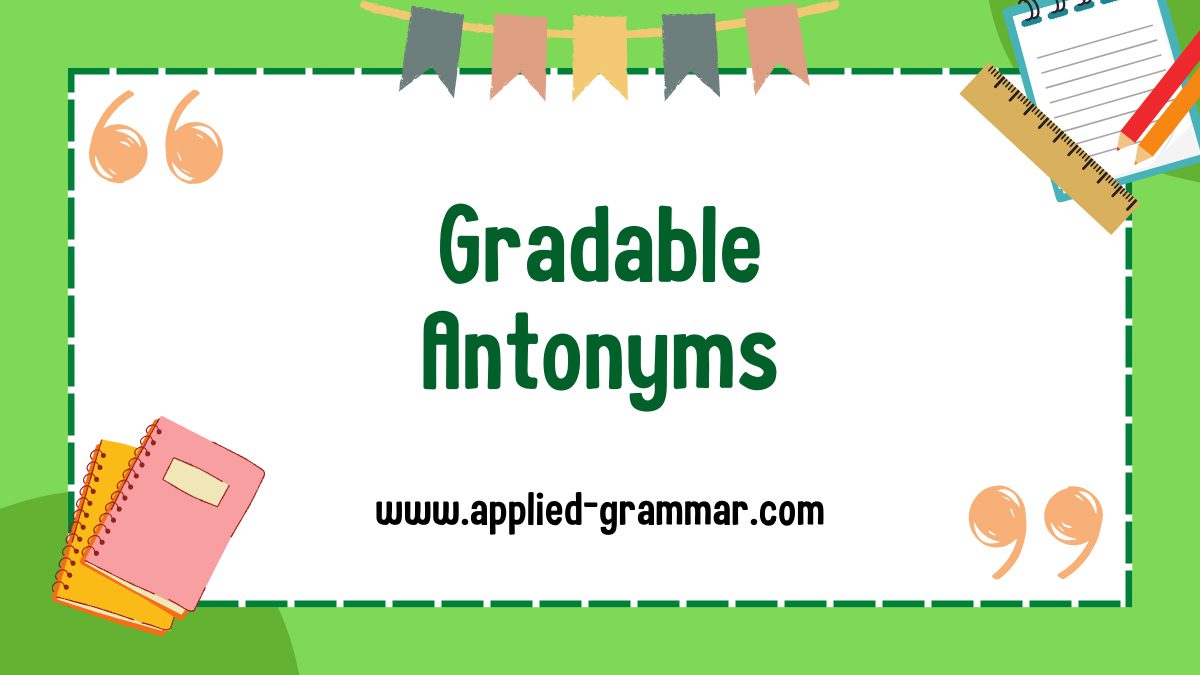Are you curious about the intriguing area of gradable antonyms? These linguistic wonders play with the shades of meaning, allowing us to express varying degrees of a quality or attribute. In this text, we’ll investigate into the concept of gradable antonyms and explore how they add depth and nuance to our language.
Imagine a spectrum where one end represents the extreme opposite of a quality, and the other end represents its complete absence. Gradable antonyms are the words that fall along this spectrum, capturing the gradations between these two extremes. For example, think of the temperature scale, where hot and cold are at the opposite ends. But what about the in-between? That’s where gradable antonyms like warm come into play, bridging the gap between hot and cold.
Key Takeaways
- Gradable antonyms are pairs of words that represent opposite ends of a spectrum or scale, allowing for varying degrees of a quality or attribute.
- They provide a way to compare and contrast the intensity or magnitude of a characteristic, capturing the shades of meaning and intensity within a particular quality.
- Gradable antonyms can be classified into complementary pairs, scalar pairs, and converse gradables, each with their own unique characteristics.
- By using gradable antonyms, you can enhance contrast, express intensity, and enable effective comparisons and contrasts in your language.
- Avoid using non-gradable antonyms interchangeably with gradable antonyms to prevent confusion or redundancy.
- Use gradable antonyms strategically and consider the context in which they are used to ensure effective communication.
What are Gradable Antonyms

Gradable antonyms are pairs of words that represent opposite ends of a spectrum with varying degrees in between. These pairs of words add depth and nuance to our language, allowing us to describe the gradations between two extremes of a quality or attribute.
Imagine looking at a room thermometer. At the bottom of the thermometer, you find the word “cold,” indicating that the room is cool. At the top of the thermometer, you see the word “hot,” indicating that the room is warm. But, there is a space in the middle where the word “warm” bridges the gap between hot and cold. This is a perfect example of gradable antonyms in action.
Gradable antonyms capture the shades of meaning and intensity within a particular quality or attribute. They allow us to describe the different levels or degrees of a quality, providing a more accurate way to express ourselves.
Here are a few examples of gradable antonyms plus to the temperature example:
- Empty and full: We can describe something as “half empty” or “half full,” emphasizing that it is neither completely empty nor completely full.
- High and low: Something can be described as “medium” when it falls in between the extremes of high and low.
- Young and old: We also have the concept of the “teenager” that acts as a gradation between a young child and an adult.
By using gradable antonyms, we can communicate with more precision, painting a clearer picture of the qualities or attributes we are describing. These words help us navigate the versatile nature of language, allowing us to express ourselves in a nuanced and effective manner.
So the next time you find yourself describing a quality or attribute, remember the power of gradable antonyms. Take advantage of these linguistic tools to add depth and clarity to your communication.
Examples of Gradable Antonyms

Opposite Ends of a Spectrum
Gradable antonyms are pairs of words that represent opposite ends of a spectrum or scale, allowing for varying degrees of a quality or attribute. These antonyms provide a way to compare and contrast the intensity or magnitude of a characteristic. Here are some examples of gradable antonyms:
- Big – Small
- Loud – Quiet
- Happy – Sad
- Brave – Cowardly
- Strong – Weak
- Young – Old
- Expensive – Cheap
- Beautiful – Ugly
By modifying the noun or verb with different intensifiers or qualifiers like “very,” “extremely,” or “slightly,” we can convey the varying degrees of the quality being described. Gradable antonyms add nuance and precision to our language, enabling us to express subtle differences in intensity or magnitude.
Intensity and Degree
Gradable antonyms allow us to describe the various degrees between two extremes of a quality or attribute. They provide a continuum of possibilities and intermediate states. For example, when we use the words “hot” and “cold,” we also have the option of describing the temperature as “warm,” which falls between hot and cold. This ability to express varying degrees of a quality adds depth and nuance to our language.
By utilizing gradable antonyms, we can communicate with more precision and clarity, painting a clearer picture of the qualities or attributes we are describing. It helps us capture the shades of meaning and intensity within a particular quality, enabling us to express ourselves in a more accurate way.
Gradable antonyms can be valuable tools in various contexts, such as storytelling, poetry, advertising, or even everyday conversations. They enrich our language and allow for more specific and nuanced expressions of our thoughts and experiences.
Summarizing, gradable antonyms represent opposite ends of a spectrum or scale, providing a continuum of possibilities and intermediate states. They allow us to express varying degrees of a quality or attribute, adding depth and nuance to our language. By utilizing gradable antonyms, we can communicate with more precision and clarity, enabling us to convey subtle differences in intensity or magnitude.
Types of Gradable Antonyms

Complementary Pairs
Complementary pairs are one type of gradable antonyms. These pairs of words represent opposite ends of a spectrum with no gray area in between. They are like two extremes that have no middle ground. For example, the words “dead” and “alive” are complementary pairs. There is no space or degree between being dead and being alive. Similarly, the words “legal” and “illegal” are also complementary pairs. When something is legal, it cannot be simultaneously illegal. Complementary pairs are binary in nature, with no room for intermediary states or degrees.
Here are some examples of complementary pairs:
- Dead / Alive
- Legal / Illegal
- Pregnant / Not pregnant
Scalar Pairs
Another type of gradable antonyms is scalar pairs. These pairs of words, instead of representing binary opposites, exist on a continuous spectrum with varying degrees in between. There are multiple adjectives that can be placed between the two words to describe different levels of the quality or attribute. For example, the words “hot” and “cold” are scalar pairs. You can use various adjectives like “warm,” “tepid,” or “freezing” to describe the different degrees of temperature between hot and cold. Scalar pairs allow for a range of possibilities and intermediate states, providing a more nuanced way to express different levels of a quality.
Some examples of scalar pairs include:
- Hot / Cold
- Tall / Short
- Young / Old
Converse Gradables
Converse gradables are a subtype of scalar pairs where one member of the pair has a privileged or more basic status. The comparative forms of these pairs form a converse pair, meaning that if you replace one member with the other, the sentence becomes contrary. For example, you can say “A is longer than B” and “B is shorter than A.” In this case, the terms “long” and “short” are converse gradables. Another example is the pair “alive” and “dead.” You can say “I feel very alive” and “This mosquito seems very dead.” By using converse gradables, you can highlight the relative differences between two qualities or attributes.
To summarize, gradable antonyms can be classified into complementary pairs, scalar pairs, and converse gradables. Complementary pairs represent binary opposites with no intermediary states, while scalar pairs represent a continuum of possibilities with various degrees in between. Converse gradables are a subtype of scalar pairs where one member holds a privileged status. Understanding the different types of gradable antonyms allows you to express varying degrees and nuances of qualities or attributes in a more precise and nuanced manner.
How to Use Gradable Antonyms

Enhancing Contrast
When using gradable antonyms, you have the opportunity to enhance contrast in your language. These antonyms represent opposite ends of a spectrum or scale, allowing you to highlight the differences in degrees or qualities. Here’s how you can effectively enhance contrast with gradable antonyms:
- Choose the right antonyms: Select a pair of gradable antonyms that accurately represent the opposing qualities you want to convey. For example, “big” and “small” or “happy” and “sad” are effective choices.
- Modify with intensifiers: To emphasize the contrast between the two qualities, you can modify the antonyms with intensifiers. Use words like “very,” “extremely,” or “incredibly” to add emphasis to one end of the spectrum. For instance, “extremely big” or “incredibly sad” convey a stronger contrast.
- Provide context: Use specific examples or scenarios to provide context and illustrate the contrasting qualities. By presenting a real-life situation, you can enhance the understanding and impact of the gradable antonyms.
Expressing Intensity
Gradable antonyms allow you to express varying degrees of intensity in your language. Whether you want to describe a person’s emotions or the size of an object, these antonyms can help you convey the desired level of intensity. Here are some tips on expressing intensity using gradable antonyms:
- Choose appropriate qualifiers: Qualifiers such as “slightly,” “moderately,” or “quite” can be used to express different levels of intensity. For example, instead of saying “happy,” you can use “moderately happy” to convey a less intense feeling.
- Consider the context: The context in which you use the gradable antonyms can play a significant role in expressing intensity. Take into account factors such as time, place, and situation to accurately convey the desired level of intensity.
- Use comparative language: When comparing two entities or qualities, gradable antonyms can be used to express the comparative intensity. For example, “She is happier than him” or “The car is slightly bigger than the other” highlight the differences in intensity.
Comparing and Contrasting
One of the key benefits of using gradable antonyms is the ability to compare and contrast qualities or attributes. These antonyms provide a scale of measurement, allowing for a nuanced understanding of the differences between two entities. Here’s how you can effectively compare and contrast using gradable antonyms:
- Identify the qualities to compare: Start by identifying the specific qualities or attributes you want to compare. For example, if comparing two paintings, you may focus on their level of intricacy or artistic expression.
- Use appropriate gradable antonyms: Select gradable antonyms that accurately represent the opposite ends of the scale for the qualities you are comparing. This will provide a clear contrast and help the comparison.
- Highlight differences in degrees: When using the gradable antonyms, emphasize the differences in degrees between the two entities. Use modifiers and qualifiers to describe the varying levels of the qualities being compared.
- Provide examples or evidence: To support your comparison and contrast, provide examples or evidence that illustrate the differences in the qualities being discussed. This will add credibility and clarity to your arguments.
Summarizing, using gradable antonyms can enhance contrast, express intensity, and enable effective comparisons and contrasts in your language. By carefully choosing the right antonyms, providing context, and using appropriate modifiers, you can convey nuanced meanings and add depth to your communication. Experiment with these techniques to enhance your writing and expression.
Common Mistakes to Avoid

Using Non-gradable Antonyms
When working with gradable antonyms, it’s important to avoid using non-gradable antonyms interchangeably. Non-gradable antonyms are pairs of words that do not have varying degrees. Common examples include words like “unique” and “correct.” These words do not have comparative or superlative forms, and their meanings cannot be intensified or weakened.
Example: Saying something is “absolutely unique” or “totally correct” is incorrect because these words already express an absolute quality. Using intensifiers with non-gradable antonyms can create confusion or redundancy in your writing.
To avoid this mistake, make sure to identify whether the antonyms in question are gradable or non-gradable. If they are non-gradable, use them as they are, without intensifiers or qualifiers. Non-gradable antonyms provide a binary opposition without variations in degree.
Overusing Gradable Antonyms
While gradable antonyms can add depth and nuance to your writing, it’s important not to overuse them. Overusing gradable antonyms can result in excessive comparisons or redundancies, which can dilute the impact of your message.
Example: Saying something is “great, greater, greatest” or “wonderful, more wonderful, most wonderful” in close proximity can become repetitive and tiresome for the reader. It’s essential to maintain a balanced and varied use of gradable antonyms to avoid monotony.
To avoid overuse, consider using gradable antonyms strategically, emphasizing the contrast or intensity when needed. Use them sparingly to prevent redundancy and maintain the impact of your comparison or contrast.
Ignoring Context
One common mistake when using gradable antonyms is ignoring the context in which they are used. The meaning of gradable antonyms can change depending on the situation or subject being described. Failing to consider the context can lead to misunderstandings or misinterpretations.
Example: Describing something as “small” can have different meanings depending on the context. A “small house” may be different from a “small insect” or a “small portion.” Ignoring these contextual differences can cause confusion.
To avoid this mistake, always consider the context in which you are using gradable antonyms. Understand the specific qualities or attributes being compared and use the appropriate gradable antonyms that align with the context. Providing additional context or clarifying the intended meaning can help ensure effective communication.
Summarizing, when working with gradable antonyms, make sure to:
- Differentiate between gradable and non-gradable antonyms
- Use gradable antonyms judiciously to avoid overuse
- Consider the context in which the gradable antonyms are used to prevent misunderstandings
By being mindful of these common mistakes, you can effectively incorporate gradable antonyms into your writing to enhance contrast, express intensity, and enable effective comparisons and contrasts in language.
Conclusion
Incorporating gradable antonyms into your writing can greatly enhance the clarity and impact of your language. By understanding the concept of gradable antonyms and the different types that exist, such as complementary pairs, scalar pairs, and converse gradables, you can effectively convey contrasting ideas and intensify your descriptions. But, it is important to be mindful of common mistakes when using gradable antonyms.
Avoid the temptation to use non-gradable antonyms interchangeably with gradable antonyms, as this can lead to confusion and misinterpretation. Also, be cautious not to overuse gradable antonyms, as this can dilute their impact and make your writing repetitive. Always consider the context in which you are using gradable antonyms, as this will ensure that your intended meaning is accurately conveyed.
By keeping these considerations in mind, you can harness the power of gradable antonyms to add depth and nuance to your writing. Whether you are contrasting ideas, expressing intensity, or making effective comparisons, gradable antonyms are a valuable tool in your linguistic arsenal. So go ahead, embrace the versatility of gradable antonyms and elevate your language to new heights.
